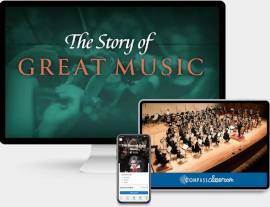What we call classical music first appeared in the Middle Ages and continued to be produced up into the twentieth century. Students taking The Story of Great Music will listen to (and perhaps watch) some of the best performances of the most important musical works created by classical composers as they learn the history of this beautiful form of artistic expression. The course necessarily covers religious music since that was a primary focus of early classical music.
The high-school course is much more in-depth than most other courses on the history of music I have reviewed, but no prior familiarity with music is required.
In the course introduction, students are given information about the best ways to listen to music, including lots of practical tips on equipment.
The Lessons
The course has 16 lessons, grouped under four broad musical eras: The Renaissance and Baroque Eras, The Classical Era, The Romantic Era, and the 20th Century. Each lesson has these five sections:
- Reading, watching, and listening:
There are three reading and watching sections within a lesson that each take about 40 minutes to complete. These sections combine text with images and links to online performances, demonstrations of various musical instruments, and examples of musical styles. Instructions often indicate how much of a lengthy piece students should listen to, but these video links are generally to excerpts rather than complete works. - Listening:
This section has playlists of recordings related to the lesson for students to listen to as much as they wish. Playlists are grouped by subject or composer. Students can access most of the recordings through either Spotify or Apple Music. Sometimes there are links to Amazon for those who want to purchase recordings. (Students might need either a Spotify or Apple Music account to access music on the playlists for each lesson.) - Watch:
Students will watch complete performances. Some details about each video are included in the text.
- Quiz
A 15-question, online quiz reviews lesson content. Students can retake the quizzes to improve their scores. - Additional Reading and Watching:
The content in these sections varies greatly. For example, a section within the lesson on Bach is titled “Bach’s Organ Music.” It has a subsection of text with an embedded video explaining the organ, toccatas and fugues (with video links to two performances), a subsection on Chorale Preludes (with video links to two performances), and a subsection on Bach’s “Passacaglia and Fugue in C Minor” (with a link to a performance). The lesson on Bach includes five such sections, although students are not expected to complete all of them. In contrast, the Additional Reading and Watching section for the lesson titled “Masters of the Piano” has only one section with links to three performances and no text.
The course says that students will spend from three and a half to six hours per week, but I can easily imagine students spending even more time. If a student struggles to complete lessons in a reasonable amount of time, parents might have them skip parts of the lessons.
Listening Journal, Research Papers, and Projects
The introductory section includes important information regarding the Listening Journal, research papers, and projects.
For the Listening Journal, the course introduction provides one or more writing prompts for each lesson that make journal entries easy for students—more like assignments rather than having to come up with something to write on their own.
The writing component of the course is in the form of a short (no longer than one page) research paper on one of the two or three topics listed for each lesson. For instance, the third lesson includes this topic: “Discover more ways in which Handel’s faith inspired his compositions. Make special note of inspiring quotations like those already in this lesson’s reading.”
Students are also provided with a list of possible projects to select for each lesson. These might involve research, writing, art, performance, or listening.
The final section in the introduction includes three useful, optional features: information on how to build a music library, video playlists, and a “30-Minute Crash Course in Music Theory.”
Summary
The Story of Great Music is a wonderful way for students to gain broad exposure to the world of classical music.









